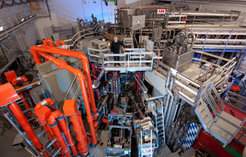Keeping them clean - high-power plasmas for ITER
Stable, clean and thermally well-insulated plasmas in ASDEX Upgrade / great prospects for ITER

IPP’s research goal is to develop a power plant that derives energy from fusion of atomic nuclei, just as the sun does. The feasibility of this objective is to be demonstrated with a fusion power of 500 megawatts by the ITER (Latin for “the way”) international experimental reactor, now being built at Cadarache, France, as an international joint venture. This requires that the fuel, an ionised low-density hydrogen gas called plasma, has to be confined free of contact in a magnetic field cage and heated to ignition temperatures of over 100 million degrees.
One of the major challenges faced is to achieve tolerable interaction between the plasma vessel and the hot plasma suspended in it. IPP favours a vessel wall made of tungsten, as the metal with the highest melting point (see IPP Info 11/2007). The ASDEX Upgrade fusion device is the only one in the world to work with a vessel completely clad with tungsten. Two years of experimentation has now succeeded in confirming the advantages afforded by the tungsten wall. It was also demonstrated that it is compatible with the favourable plasma states needed for ITER, e.g. the high-confinement regime developed at IPP.
Clean plasmas
First it had to be shown that clean plasmas can be obtained with the new tungsten wall. This is necessary because high-energy plasma particles can dislodge atoms from the wall, which then penetrate into the plasma and contaminate it. Unlike the light hydrogen, the heavy atoms from the wall are not completely ionised, despite the high fusion temperatures. The more electrons there are still bound to the atomic nuclei, the more energy they extract from the plasma and re-emit as ultraviolet or X-ray light. They thus cool the plasma, rarefy it and reduce the fusion yield.
The scientists at ASDEX Upgrade have now been able to show that with properly geared discharges hardly any tungsten particles from the wall can penetrate to the plasma. On the contrary, the clean plasmas obtained with the new wall can lead to excessive loading of individual sections of the wall at high heating power. In particular, damage could be inflicted on the divertor, comprising specially equipped collector plates at the bottom of the vessel, to which the plasma edge is magnetically directed.
Well-insulated, stable plasmas
This was remedied by applying a familiar technique: to prevent all of the energy from hitting the divertor plates in the form of fast plasma particles, impurities were deliberately injected into the edge of the plasma. Contact with the hot plasma makes them fluorescent, thus enabling them to gently remove the energy from the plasma by spreading it over the vessel wall as ultraviolet or X-ray light. Unlike in the hot plasma core, where this cooling effect has to be avoided, it is very useful at the plasma edge: before the fast plasma particles arrive at the divertor plates, they have already lost their energy to the impurity atoms. Contrary to the experience gained hitherto, particularly nitrogen in conjunction with the tungsten wall proved to be a suitable impurity material.

Nitrogen helped to achieve good plasma states beyond all expectation: despite the very high heating power of 20 megawatts the nitrogen cooling reduced the load on the divertor plates to a tolerable level. At the core the plasmas afforded a high degree of purity and good thermal insulation. The energy content of the plasmas was one of the highest ever obtained in the device. This eminently satisfies all ITER requirements. This is all the more gratifying in that ASDEX Upgrade comes closer to ITER than any other device in the world in respect of the most important comparative parameter, viz. the heating power in relation to the plasma radius.
Even the dreaded ELM instabilities lost their awesomeness in the nitrogen-cooled plasmas: these edge-localised mode instabilities of the plasma have a particularly adverse effect on the divertor, because they abruptly hurl bunched plasma particles and energies onto the plates. For the large-scale ITER device they present a major challenge. On the other hand, the ELMs also cause impurities to be ejected from the plasma. What is therefore needed instead of the usual heavy ELM impacts is weaker but more frequent ELMs. This is exactly what is found in the nitrogen-cooled plasmas.
Further plans
As it is not yet certain that this method can be extended to larger devices such as ITER or a future fusion power plant, other ELM control methods are also to be investigated in ASDEX Upgrade: at present auxiliary magnetic control coils are being incorporated in the plasma vessel. As of August they are to be enlisted to magnetically control the ELMs. By 2012 a total of 24 control coils are to be incorporated, this being a system quite similar to that also envisaged for ITER.
Isabella Milch

